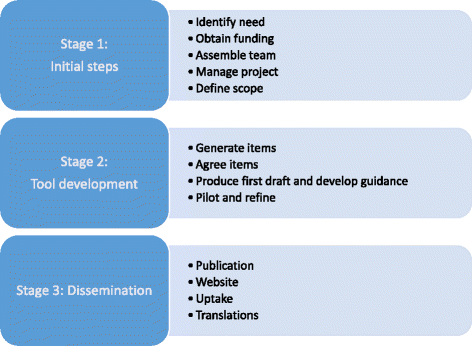A proposed framework for developing quality assessment tools
- PMID: 29041953
- PMCID: PMC5646161
- DOI: 10.1186/s13643-017-0604-6
A proposed framework for developing quality assessment tools
Abstract
Background: Assessment of the quality of included studies is an essential component of any systematic review. A formal quality assessment is facilitated by using a structured tool. There are currently no guidelines available for researchers wanting to develop a new quality assessment tool.
Methods: This paper provides a framework for developing quality assessment tools based on our experiences of developing a variety of quality assessment tools for studies of differing designs over the last 14 years. We have also drawn on experience from the work of the EQUATOR Network in producing guidance for developing reporting guidelines.
Results: We do not recommend a single 'best' approach. Instead, we provide a general framework with suggestions as to how the different stages can be approached. Our proposed framework is based around three key stages: initial steps, tool development and dissemination.
Conclusions: We recommend that anyone who would like to develop a new quality assessment tool follow the stages outlined in this paper. We hope that our proposed framework will increase the number of tools developed using robust methods.
Keywords: Quality; Risk of bias; Systematic reviews.
Conflict of interest statement
Ethics approval and consent to participate
Not applicable.
Consent for publication
Not applicable.
Competing interests
The authors declare that they have no competing interests.
Publisher’s Note
Springer Nature remains neutral with regard to jurisdictional claims in published maps and institutional affiliations.
References
-
- Centre for Reviews and Dissemination. Systematic reviews: CRD’s guidance for undertaking reviews in health care [internet]. In. York: University of York; 2009. [accessed 23 Mar 2011].
-
- Higgins JPT, Green S (eds.): Cochrane handbook for systematic reviews of interventions [Internet]. Version 5.1.0 [updated March 2011]: The Cochrane Collaboration; 2011. [accessed 23 Mar 2011].
-
- Torgerson D, Torgerson C. Designing randomised trials in health, education and the social sciences: an introduction. New York: Palgrave MacMillan; 2008.
Publication types
MeSH terms
Grants and funding
LinkOut - more resources
Full Text Sources
Other Literature Sources


